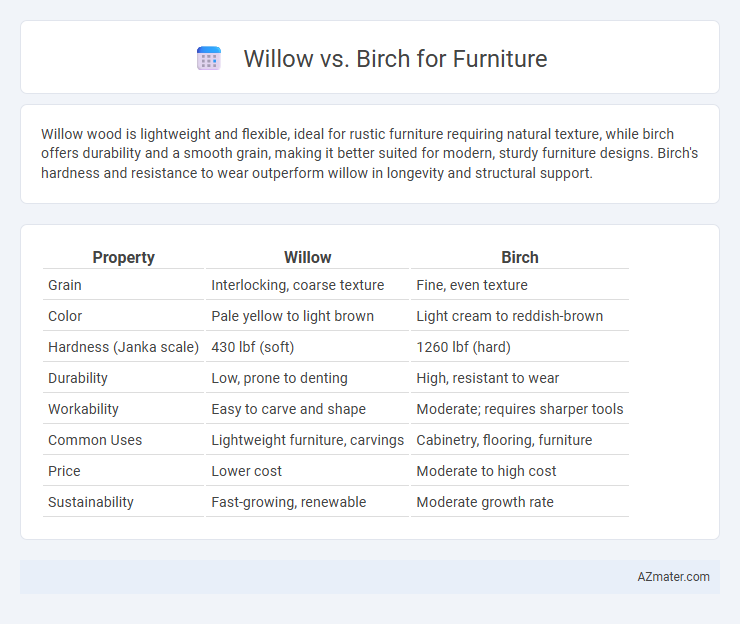Willow wood is lightweight and flexible, ideal for rustic furniture requiring natural texture, while birch offers durability and a smooth grain, making it better suited for modern, sturdy furniture designs. Birch's hardness and resistance to wear outperform willow in longevity and structural support.
Table of Comparison
| Property | Willow | Birch |
|---|---|---|
| Grain | Interlocking, coarse texture | Fine, even texture |
| Color | Pale yellow to light brown | Light cream to reddish-brown |
| Hardness (Janka scale) | 430 lbf (soft) | 1260 lbf (hard) |
| Durability | Low, prone to denting | High, resistant to wear |
| Workability | Easy to carve and shape | Moderate; requires sharper tools |
| Common Uses | Lightweight furniture, carvings | Cabinetry, flooring, furniture |
| Price | Lower cost | Moderate to high cost |
| Sustainability | Fast-growing, renewable | Moderate growth rate |
Willow vs Birch: An Overview for Furniture Use
Willow and birch are both popular hardwood choices for furniture, with birch known for its fine grain, light color, and strong durability, making it ideal for cabinetry and structural pieces. Willow, softer and more flexible, offers a unique aesthetic with its rustic texture and is often used for woven or lightweight furniture. Birch provides superior hardness and resistance to dents compared to willow, which excels in applications requiring flexibility and intricate crafting.
Wood Grain and Aesthetic Differences
Willow wood features a fine, consistent grain with a pale, creamy coloration that complements minimalist and rustic furniture designs, offering a smooth texture and subtle aesthetic appeal. Birch showcases a more pronounced, wavy grain pattern with a warm, golden hue that enhances traditional and contemporary furniture pieces by adding depth and character. The distinct wood grain and color variations between willow and birch influence their visual impact and suitability for different interior styles.
Durability and Strength Comparison
Willow wood is lightweight and flexible but lacks the hardness and durability necessary for long-lasting furniture, making it prone to dents and scratches over time. Birch wood, known for its high density and hardness, offers superior strength and resilience, ensuring furniture pieces maintain their integrity and appearance under regular use. For furniture requiring robust durability and strength, birch is the preferred choice due to its resistance to wear and structural stability.
Workability and Crafting Ease
Willow wood is lightweight and soft, offering excellent workability with hand tools and machines, making it ideal for intricate carving and detailed furniture crafting. Birch, known for its hardness and fine grain, provides greater durability but can be more challenging to shape and requires sharper tools for smooth finishes. Both woods finish well, but willow's ease of cutting and minimal splintering gives it an advantage for craftsmen prioritizing speed and precision in furniture making.
Weight and Density Factors
Willow wood is lighter with a density of approximately 410 kg/m3, making it ideal for lightweight furniture pieces that require easy mobility. Birch, with a higher density around 670 kg/m3, offers greater durability and strength, making it suitable for furniture that demands sturdiness and long-term resilience. The contrast in weight and density between willow and birch directly influences their respective applications in furniture design, balancing portability and robustness.
Cost and Market Availability
Willow wood typically costs less than birch, making it a budget-friendly option for furniture production. Birch offers greater market availability due to its widespread growth in North America and Europe, ensuring steady supply for manufacturers and consumers. Despite its higher price, birch is favored for its durability and fine grain, which enhances its demand in the premium furniture market.
Sustainability and Eco-Friendliness
Willow wood is highly sustainable due to its rapid growth and ability to regenerate quickly, making it an eco-friendly choice for furniture production. Birch, while slower in growth compared to willow, is still considered sustainable because it commonly grows in managed forests with responsible harvesting practices. Both woods offer durable, biodegradable options, but willow's faster replenishment rate gives it an edge in reducing environmental impact.
Finishing and Staining Properties
Willow wood offers a smooth surface that readily absorbs stains, producing rich and warm finishes ideal for rustic or traditional furniture. Birch wood is prized for its tight, uniform grain which enhances even stain absorption, resulting in a clean, consistent finish perfect for modern and contemporary designs. The finishing properties of birch allow for a wide range of stain colors without blotching, whereas willow's porous texture may require pre-treatment to achieve uniform staining.
Best Furniture Types for Willow and Birch
Willow is ideal for lightweight, flexible furniture such as woven chairs, baskets, and decorative accents due to its pliability and durability. Birch wood excels in crafting sturdy furniture pieces like cabinets, tables, and chairs because of its hard, dense grain and smooth finish. Selecting birch for structural items ensures long-lasting strength, while willow suits intricate, delicate designs requiring gentle curves and natural resilience.
Pros and Cons: Choosing Between Willow and Birch
Willow offers a lightweight and flexible wood ideal for intricate furniture designs, but it lacks the durability and hardness found in birch, making it less suitable for heavy-use pieces. Birch provides excellent strength, smooth grain, and resistance to dents, making it a popular choice for sturdy, long-lasting furniture yet can be heavier and more challenging to work with. Selecting between willow and birch depends on the balance between desired aesthetics, structural requirements, and budget constraints in furniture crafting.

Infographic: Willow vs Birch for Furniture
 azmater.com
azmater.com